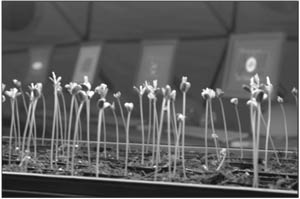|
|
|
 |
 |
 |
 |

The Strange Case of Steve Kurtz:
Critical Art Ensemble and the Price of Freedom
By Robert Hirsch
From Afterimage: the Journal of Media Arts and Cultural Criticism,
May/June 2005
(continued)
RH: How was it received?

Artwork from the project "Molecular Invasion" (2000)
by Critical Art Ensemble. |
SK: I don’t know. The only biotech project that I can say was well received was "GenTerra" (2001-2002). The reason I can say this is because the London Council did exit interviews and surveyed people. Both children and adults were enthusiastic and apparently learned quite a bit about genetic modifi- cation. The Council representatives told us they thought their money was well spent.
RH: What was the outcome with Monsanto?
SK: It just fizzled out. There was nothing it could do.
RH: What have been typical reactions to CAE’s work?
SK: Mostly condemnations and threats from police, lawyers, churches, political figures, the FBI and just about any disciplinary agency you can think of. But any time we created a micro-public sphere that encouraged critical dialogue and free thinking we were pretty happy.
RH: What happened with "Free Range Grains" at MASS MoCA?
SK: As part of "The Interventionists" exhibition, we were going to do "Free Range Grains" and test organic food in the U.S. to see if it was genetically modified. We were not able to do the latter half of the project because the FBI confiscated our lab from my home. We set up everything but the lab and put out a sign with an explanation of why we were not doing the performance. Over the months that followed MASS MoCA also put up all the press coverage of the case. It’s a good conversation piece and immediately illustrates the cost of doing interventions.
RH: How did you meet your late wife Hope, what was her role in CAE and how will her death affect CAE?
SK: We met in our freshman philosophy class at UNT in 1977. We were lovers and cultural, political and intellectual partners from that first day of class until she died 27 years later. She was the gateway to the public, our editor, poet and voice of reason. Before any project was released, she reviewed all the materials, suggested necessary changes and in the end gave final approval. Her genius lay in her talent for pattern recognition (especially text). She could look at something and even if she didn’t understand the content (which was rare) she knew if something was wrong. I call her the voice of reason, because whenever a project was getting too abstract, specialized or too "insiderish" she would call us on it. We don’t know the consequences of her death yet, but we will have a hard time continuing CAE without her.
afterimage • may/june 2005
ROBERT HIRSCH is the author of Exploring Color Photography: From the Darkroom to the Digital Studio; Seizing the Light: A History of Photography; and Photographic Possibilities: The Expressive Use of Ideas, Materials & Processes, Second Edition. His most recent project, "World in a Jar: World and Trauma" has been touring the U.S. For more information visit: http://www.lightresearch.net.
• • • NOTES
1. In the Spring of 2001, six men of Yemenite decent from Lackawanna, New York, a poverty stricken former steel town south of Buffalo, were charged with attending an al-Qaeda training camp in Afghanistan. In September 2002 they were arrested and each defendant admitted training at the camp, but denied any intention to engage in acts of terrorism. Facing 25 years in prison, all pleaded guilty and received sentences of eight-10 years in December 2003. The truth about this case remains murky because there was not a public trial. Critics claim the guilty pleas were extracted in the post 9-11 atmosphere of fear to mitigate the possibility of harsher punishment, including the threat to deem them "enemy combatants" and to legitimate a dubious prosecution.
2. RoundUp Ready corn and soybeans are genetic engineered plants. According to the University of Maine, "Roundup Ready plants produce the same natural proteins as any other plant with one notable exception. These plants make an additional protein which allows them to grow in the presence of Glyphosate, known commercially as 'Roundup,' one of the most widely-used herbicides employed by back-yard gardeners, homeowners, golf courses and commercial farms for the past 25 years. The protein is not a toxin to plants, animals, insects, humans or bacteria." However, in 1999 opponents of genetic engineering, identifying themselves as "Seeds of Resistance" claimed that they did not want "poison pollen" in Maine and cut down part of the crop grown by the University of Maine Cooperative Extension, attracting national attention. Organic producers are concerned about pollen drift—the transport of pollen from GM (genetically modified) corn to non-GM corn is increasing, which could result in their product not meeting organic standards and potentially losing their organic certification.
FOR MORE INFORMATION For both detailed background as well as the latest information about the case and how you can offer support visit: www.caedefensefund.org. For more information on CAE visit www.critical-art.net. CAE publications are available at www.autonomedia.org as PDFs. The website states "This book may be freely pirated and quoted. The authors and publisher, however, would like to be informed at": Autonomedia, P.O. Box 568, Williamsburgh Station, Brooklyn, NY 11211-0568; phone & fax: (718) 963-2603.
|
|
|
 |
 |
 |
 |
|
|
|